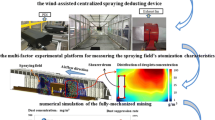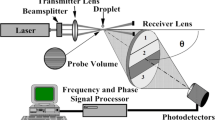Abstract
In order to evaluate the dust suppression performance with a spraying system at the fully mechanized excavation face, an airflow–droplet–dust multiphase coupling model was established based on the Eulerian–Lagrangian method. Subsequently, the model’s accuracy was validated experimentally using a self-developed system for measuring dust suppression efficiency. For the pressure/exhaust hybrid ventilation condition, the following conclusions can be drawn: with an increase of airflow migration distance, the number of vortices gradually decreased, and dust-capturing probability caused by collision with wall decreased gradually along the axial direction of the roadway. Jointly driven by the rebounded airflow, the entrainment effect of high-velocity jets around the pressure inlet, and the transverse vortex field near the cutting face, three high-concentration dust particle clusters, denoted as particle flows I, II, and III, were formed, and the distribution patterns of dust particle clusters after the implementation of different spray schemes were determined. By analyzing the droplet field distribution surrounding the coal cutting head and comparing the dust suppression performance, the study proposed two optimal spray schemes: with gravity-driven supply of water, the spray scheme K2.0–4 MPa delivered optimum dust suppression performance, and the mean dust concentrations at specific fixed operating points dropped to 130 mg/m3; after utilizing a booster pump, the P2.0–8 MPa spray scheme delivered optimum dust suppression performance, with a mean dust concentration at fixed operating points dropping to 65 mg/m3. After applying the K2.0–4 MPa and P2.0–8 MPa schemes, the dust suppression performance was better for the dust with bigger size. The dust suppression efficiencies for the respirable dust were less than 60.7 and 72.5%, respectively. Other dust prevention measures should be taken to further reduce the dust hazard.





















Similar content being viewed by others
References
Alam M (2006). An integrated approach to dust control in coal mining face areas of a continuous miner and its computational fluid dynamics modeling
ANSYS 17.1 help (2017) FLUENT theory guide
Bhasker C (2011) Flow simulation in electro-static-precipitator (ESP) ducts with turning vanes. Adv Eng Softw 42:501–512
Branny M, Karch M, Wodziak W, Jaszczur M, Nowak R, Szmyd JS (2014) An experimental validation of a turbulence model for air flow in a mining chamber. J Phys Conf Ser 530:12029
Branny M, Jaszczur M, Wodziak W, Szmyd J (2016). Experimental and numerical analysis of air flow in a dead-end channel. p. 32045
Chen Y (2010) Study on control of dust at driving fully mechanized face based on air curtain technology. Liaoning Technical University
Dolinski R, Bode F, Nastase I, Meslem A, Croitoru C (2013) Influence of the choice of the inlet turbulence intensity on the performance of numerically simulated moderate Reynolds jet flows—part 1—the near exit region of the jet. INCAS Bull 5:25–36. https://doi.org/10.13111/2066-8201.2013.5.4.3
Douglas P, John O (2007) Airborne dust capture and induced airflow of various spray nozzle designs. Aerosol Sci Technol 41:711–720
Fuliotto R, Cambuli F, Mandas N, Bacchin N, Manara G, Chen Q (2008) Experimental and numerical analysis of heat transfer and airflow on an interactive building facade. Energy Build 42:23–28
Gao H, Stenstrom MK (2018) Evaluation of three turbulence models in predicting the steady state hydrodynamics of a secondary sedimentation tank. Water Res 143:445–456
Haider A, Levenspiel O (1989) Drag coefficient and terminal velocity of spherical and nonspherical particles. Powder Technol 58:63–70
Han Z, Parrish S, Farrell PV, Reitz RD (1997) Modeling atomization processes of pressure-swirl hollow-cone fuel sprays. At Sprays 7:663–684
Han SH, Yang XF, Wang PF, Tan XH (2017) Study on Spray Dust Settling Technology of Fully Mechanized Mining Face. Technol. Innov. Appl 11:93-94
Hefny MM, Ooka R (2008) Influence of cell geometry and mesh resolution on large eddy simulation predictions of flow around a single building. Build Simul 1:251–260
Jaramillo JE, Pérez-Segarra CD, Rodriguez I, Oliva A (2008) Numerical study of plane and round impinging jets using RANS models. Numer Heat Transf Part B Fundam 54:213–237
Jaszczur, M., Nowak, R., Szmyd, J.S., Branny, M., Wodziak, W.B.T.-J. of P.C.S, 2012. Experimental validation of the transport phenomena in T-shape channel flow. p. 12037
Kurnia JC, Sasmito AP, Mujumdar AS (2014) Dust dispersion and management in underground mining faces. Int J Min Sci Technol 24:39–44
Kurnia JC, Sasmito AP, Mujumdar AS (2014a) CFD simulation of methane dispersion and innovative methane management in underground mining faces. Appl Math Model 38:3467–3484
Launder BE, Spalding DB (2014) The numerical computation of turbulent flows. Comput Methods Appl Mech Eng 3:269–289
Li X.G., 2014. Modelling and simulation of the gas-atomization process of metal melts for metal-matrix-composite production. Universität Bremen, Shaker Verlag, Achen dissertation
Li C, Li Z, Gao L (2014) Arrangement of air duct in tunneling working face based on the distribution laws of airflow and dust. J China Coal Soc 39:130–135
Liu Y, Wang S, Deng Y, Ma W, Ying M (2016) Numerical simulation and experimental study on ventilation system for powerhouses of deep underground hydropower stations. Appl Therm Eng 105:151–158
Liu Q, Nie W, Hua Y, Peng H, Liu Z (2018) The effects of the installation position of a multi-radial swirling air-curtain generator on dust diffusion and pollution rules in a fully-mechanized excavation face: a case study. Powder Technol:329
Lu YZ, Akhtar S, Sasmito AP, Kurnia JC (2017) Prediction of air flow, methane, and coal dust dispersion in a room and pillar mining face. Int J Min Sci Technol 27:657–662
Li M, Aminossadati SM, Wu C (2016) Numerical simulation of air ventilation in super-large underground developments. Tunn Undergr Sp Technol Inc Trenchless Technol Res 52:38–43
Mohebbi A, Taheri M, Fathikaljahi J, Talaie MR (2003) Simulation of an orifice scrubber performance based on Eulerian/Lagrangian method. J Hazard Mater 100:13–25
National Health Commission (2019) Occupational disease report of the National Health Commission, the National Occupational Disease Report. Available at <http://www.nhc.gov.cn/xcs/s7847/201905/7f257f9c8c1c4d6eb66bf671788392fe.shtml>. Accessed on 20 May 2019
Nie W, Cheng WM, Zhou G, Xue J, Cui XF (2014) Research and application on external spray secondary dust falling device with negative pressure of roadheader. J China Coal Soc 39:2446–2452
Orourke, P.J., Amsden, A.A., 1987. The TAB method for numerical calculation of spray droplet breakup
Pak SI, Chang KS (2006) Performance estimation of a Venturi scrubber using a computational model for capturing dust particles with liquid spray. J Hazard Mater 138:560–573
Ren T, Wang Z, Cooper G (2014) CFD modelling of ventilation and dust flow behaviour above an underground bin and the design of an innovative dust mitigation system. Tunn Undergr Sp Technol 41:241–254
Rhodes, M., 2014. Introduction to particle technology. Part. Accel. Astrophys. Plasmas Geosp. Beyond
Walton, WH, Woolcock, A (1960) Aerodynamic capture of particles, vol 185. Pergamon, pp 664–665
Sa Z, Li F, Qin B, Pan X (2012) Numerical simulation study of dust concentration distribution regularity in cavern stope. Saf Sci 50:857–860
Tomb TF, Emmerling JE, Kellner RH (1972) Collection of airborne coal dust by water spray in a horizontal duct. Am Ind Hyg Assoc J 33:715
Vukasinovic B, Glezer A, Smith MK (2002) Droplet formation during the atomization of a viscous liquid. Phys Fluids 14:S6–S6
Wang Z, Ren T (2013) Investigation of airflow and respirable dust flow behaviour above an underground bin. Powder Technol 250:103–114
Wang PF, Liu RH, Meng T, Wen Z, Zhe G (2015) Experimental study on atomization characteristics and dust suppression efficiency of high-pressure spray in underground coal mine. J China Coal Soc
Wang H, Wang C, Wang D (2017) The influence of forced ventilation airflow on water spray for dust suppression on heading face in underground coal mine. Powder Technol:320
Nie W, Wei WL, Cai P, Liu ZQ, Liu Q, Ma H, Liu HJ (2018) Simulation experiments on the controllability of dust diffusion by means of multi-radial vortex airflow. Adv Powder Technol 29:835-847
Xu C, Nie W, Liu ZQ, Peng HT, Yang SB, Liu Q (2019) Multi-factor numerical simulation study on spray dust suppression device in coal mining process. Energy. 182:544–558
Yu H, Cheng W, Wu L, Hao W, Yao X (2017) Mechanisms of dust diffuse pollution under forced-exhaust ventilation in fully-mechanized excavation faces by CFD-DEM. Powder Technol 317:31–47
Zhou Q, Qin B, Wang F, Wang H, Hou J, Wang Z (2015) Effects of droplet formation patterns on the atomization characteristics. Powder Technol 344:570–580
Zhou G, Zhang Q, Bai R, Fan T, Wang G (2017) The diffusion behavior law of respirable dust at fully mechanized caving face in coal mine: CFD numerical simulation and engineering application. Process Saf Environ Prot 106:117–128
Zhou G, Ma Y, Fan T, Wang G (2018) Preparation and characteristics of a multifunctional dust suppressant with agglomeration and wettability performance used in coal mine. Chem Eng Res Des 132:S0263876218300868
Funding
This work was financially supported by the State Key Program of National Natural Science of China (Grant no. U1261205), National Natural Science Foundation of China (Grant no. 51474139), and National Natural Science Foundation of China (Grant no. 51504142).
Author information
Authors and Affiliations
Corresponding author
Additional information
Responsible Editor: Marcus Schulz
Publisher’s note
Springer Nature remains neutral with regard to jurisdictional claims in published maps and institutional affiliations.
Rights and permissions
About this article
Cite this article
Yu, H., Cheng, W., Xie, Y. et al. Spray dedusting scheme under hybrid ventilation at a fully mechanized excavation face. Environ Sci Pollut Res 27, 7851–7871 (2020). https://doi.org/10.1007/s11356-019-07453-4
Received:
Accepted:
Published:
Issue Date:
DOI: https://doi.org/10.1007/s11356-019-07453-4




